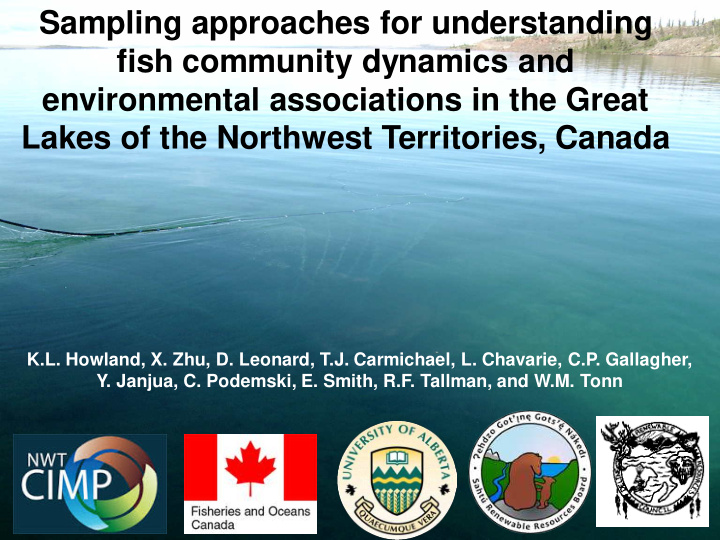



Sampling approaches for understanding fish community dynamics and environmental associations in the Great Lakes of the Northwest Territories, Canada K.L. Howland, X. Zhu, D. Leonard, T.J. Carmichael, L. Chavarie, C.P. Gallagher, Y. Janjua, C. Podemski, E. Smith, R.F. Tallman, and W.M. Tonn
2 ALASKA 4 5 CANADA 1 3 2
Mackenzie River Basin Hydro Dam Pulp Mill Coal Mine Uranium Mine Oil Sands Diamond Mine Gold Mine Mine Remediation
Surface temperature anomaly for January 2010 relative to the mean for 1951–1980 (Hoegh-Guldberg & Bruno 2010, NASA GISS) High latitude areas have experienced disproportionate levels of climate warming in recent years
• Despite their significance and the potential for impacts to these lakes, there is minimal knowledge of their ecosystems • Limited studies to date have focussed on harvested fish species
Objectives Design surveys that: • Build on existing time series for large-bodied fish species to address questions regarding stock status & sustainable harvest levels • Address knowledge gaps regarding the lake ecosystems & the relationships of different ecosystem components to fisheries production • Develop baseline from which to assess impacts of climate change & other anthropogenic drivers on lake ecosystems & harvested fish
Considerations in study design • Large surface area (Great Slave 28,930 km 2 , Great Bear 31,080 km 2 ) • Remote, limited infrastructure • Short navigable season • Small boats • Limited resources (financial and human) • Minimal backgound information, esp. habitat; crude bathymetry Great Bear Lake July 25, 2004
Great Bear Lake DEASE ARM PLUMMERS GREAT (TAH – 2000) BEAR LAKE LODGE ARCTIC CIRCLE LODGE SMITH ARM (TAH – 2500) BRANSON’S LODGE GREAT BEAR TROPHY LODGE PLUMMER’S GREAT BEAR LAKE LODGE GREAT BEAR (Original location LODGE closed 1968) KEITH ARM KEITH ARM McVICAR ARM (TAH – 1500) DELINE (FORT FRANKLIN) GREY GOOSE LODGE Subsistence use only Areas fished by lodges Management zone boundaries
Great Slave Lake management zones 2011
Methods - Ecosystem Sampling Design Inshore (0-2 m) Pelagic-profundal Pelagic-profundal Pelagic-deep (21-50 m) (51-100 m) profundal (100-150 m) Littoral (3-20 m) McVicar Arm (2013)
Benthic invertebrate diversity Great Bear Lake 2012 45 Kick Net Ponar Grab Number of taxonomic groups in a sample 40 35 30 25 20 15 10 5 0 Red (0-2 m) Yellow (3-20 m) Green (21-50 m) Purple (51-100 m) Blue (100+ m) Sampling strata
Benthic invertebrate community composition Great Bear Lake 2012 Kick Net Ponar Grab 100 90 80 Average frequency (%) Platyhelminthes 70 Nematoda 60 Annelida 50 Mollusca Malacostraca 40 Copepoda 30 Ostracoda Arachnida 20 Insecta 10 0 Red (0-2 m) Yellow (3-20 m) Green (21-50 m) Purple (50-100 m) Blue (>100 m) Sampling strata
McVicar Arm, Great Bear Lake 2013 Camp 2 Camp 1
Depth Water Zooplankton Benthic Inverts Fish Zone quality (plankton net) (Kick, Ponar grab) (gill nets) 0-2 m Seine only 3-20 m 21-50 m Lower/ Upper Lower/ Upper 51-100 m Lower/ Mid/ Upper Lower/ Mid/ Upper 100+ m Lower/ Mid/ Upper Lower/ Mid/ Upper Composition, Temp, Chl a , DO, pH, Composition, Composition, Abundance, Abundance, Biomass Tubidity, Conductivity Abundance, Biomass Biomass, Demographics
Temporally intensive community-based monitoring Off shore (60 m depth) temperature array; zooplankton; benthic invertebrates Nearshore benthic/ terrestrial invertebrates Deline X Great Bear Lake Annual Keith Arm 2011
Water Temperature – Great Bear Lake Keith Arm (2012) McVicar Arm (2013) Epilimnion 0-2 m 3-20 m Metalimnion 21-50 m 51-100 m Hypolimnion 100+ m
Great Bear Lake Development of thermocline in 2012 & 2013 (Johnson 1975 JFRBC)
Chlorophyll a – Great Bear Lake Keith Arm (2012) McVicar Arm (2013) Epilimnion 0-2 m 3-20 m Metalimnion Metalimnion 21-50 m 51-100 m Hypolimnion 100+ m
Benthic invertebrate abundance Great Bear lake 2012 1000 Kick Net Ponar Grab Number of aquatic invertebrates in a sample 900 800 700 600 500 400 300 200 100 0 Red (0-2 m) Yellow (3-20 m) Green (21-50 m) Purple (51-100 m) Blue (100+ m) Sampling strata
Associations of Fish with Environment (Great Slave Lake 2013) Deep and cold water Shallow water Low High productivity Higher productivity High productivity Shallow and warm water Low productivity - Deep water Low productivity Higher dissolved oxygen Shallow Deep
Decision Making Sustainable Harvest Levels Population dynamics models Adaptive management Inform management of species (e.g. salmonids ) where there is high polymorphism & intraspecific diversity in demographic traits Predictive ecosystem models State of ecosystem/fisheries, future impacts, climate change Trans boundary agreements Influence decision making in the South EA processes Comprehensive baseline, standardized monitoring protocols
Acknowledgements • NWT Cumulative Impacts Monitoring Program • Sahtu Renewable Resources Board • Deline Renewable Resources Council • Deline Lands and Finance Corporation • GNWT Renewable Resources Deline • DFO Hay River & Yellowknife • Polar Continental Shelf Project • Natural Sciences and Engineering Research Council • Canadian Circumpolar Institute • Field Work 2012: Darren Kenny, Bobby Modeste, Allison Tatti, Gerald Tutcho, Archie Vitale; DFO Winnipeg - Dave Boguski, Kristin Hynes • Field Work 2013: Chris Yukon, Archie Vitale, Allison Tatti, Morris Betsidea, Isodore Betsidea; DFO Winnipeg - Kristen Adair
Recommend
More recommend